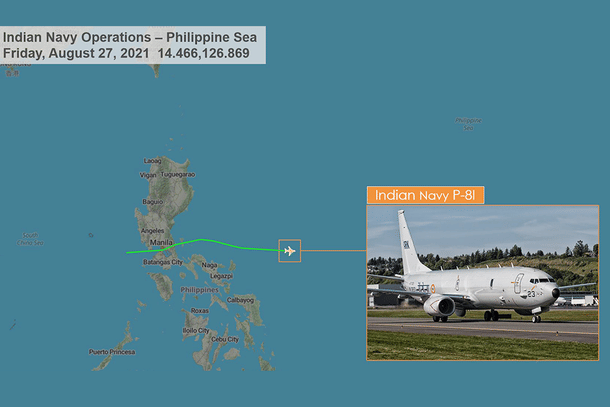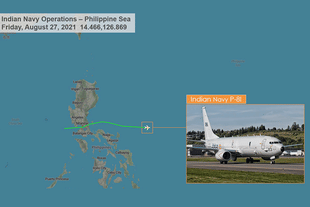Defence
Indian Navy's P-8I Submarine Hunting Aircraft Spotted Flying Near South China Sea
Swarajya Staff
Aug 27, 2021, 04:50 PM | Updated Aug 28, 2021, 10:15 PM IST
Save & read from anywhere!
Bookmark stories for easy access on any device or the Swarajya app.


A P-8I maritime patrol aircraft of the Indian Navy was spotted flying over the Philippines, close to the South China Sea, almost all of which is claimed by China.
The submarine-hunting aircraft is in the region to participate in the Malabar Exercise, featuring the navies of all four Quad countries.
This edition of the Malabar naval exercise is being hosted by the United States Navy in the Western Pacific, off the coast of Guam. The area is not far from the South China Sea, where China has built a large number of artificial islands and militarized them to strengthen its territorial claims over these waters, which host some of the busiest shipping lanes in the world.
China opposes the deployment of foreign military vessels in the region, including the Freedom of Navigation Patrols conducted by the US to assert its right to use the waterways in the South China Sea.
Before reaching Guam in Western Pacific for the Malabar Exercise, the Indian Naval taskforce comprising of Guided Missile Destroyer Ranvijay, Guided Missile Frigate Shivalik, Anti-Submarine Corvette Kadmatt and Guided Missile Corvette Kora was also deployed in the South China Sea. The Indian Navy held exercises with the navies of the Philippines and Vietnam, two of China's neighbours, which dispute its claims over parts of the South China Sea.
"These maritime initiatives enhance synergy and coordination between the Indian Navy and friendly countries, based on common interests and commitment towards Freedom of Navigation at sea," the Indian Navy said on 2 August.
A fleet of P-8I submarine-hunting aircraft of the Indian Navy has joined the naval task force for the Malabar exercise, which will see participation from Japan and Australia, apart from the US. The fleet will participate in an anti-submarine warfare drill during the exercise.
P-8I Aircraft
The Navy received its tenth P-8I aircraft from Boeing in July this year. The aircraft, part of the second batch of four P-8Is bought by India, arrived in Goa from Seattle in the US after stops at Hawaii, Guam and Brunei.
Nine of these aircraft are already in service with the Indian Navy, the largest foreign customer of the P8 platform.
While nine are in service, two more are likely to be delivered this year, and six more are being procured. The Navy, reports say, plans to have a total of 22 of these aircraft in the next few years to keep an eye on Chinese movements in the Indian Ocean Region, most importantly its submarines.
India has also used the aircraft to track Chinese deployments along the Line of Actual Control amid the ongoing standoff in eastern Ladakh. Indian Navy P8s were seen flying towards Ladakh at least twice.
The aircraft was used to monitor Chinese movements along the border during the 73-day-long Doklam standoff in 2017. As Captain D K Sharma (Retd), who was serving as the spokesperson and Public Relation Officer of the Indian Navy, revealed later, “The aircraft were live-streaming data to support decision making during the Doklam face-off”.
The aircraft, a report says, was also put to use “to keep an eye on movement of Pakistani troops after the Pulwama terror attack last year”.
The P-8Is come equipped with the AN/APY-10 radar, which its maker Raytheon describes as a “maritime, littoral and overland surveillance radar”. As it is clear from the description, the radar can be used to monitor ground movement, and is capable of providing data in all-weather conditions, both at night and day.
In the Synthetic Aperture and Inverse synthetic-aperture mode, the AN/APY-10 radar can penetrate through clouds and foliage to give detailed images of the surface below. Images produced by the radar in these modes can give details such as the size of objects and structures on the surface, movement and change.
Talking to Tyler Rogoway of TheWarZone, a pilot of Patrol Squadron Five, a maritime patrol squadron of the United States Navy, which is also known as the "Mad Foxes,” said: “ESM (electronic surveillance measures) is used to collect a wide range of emitters used by... land based facilities at extended ranges. It allows us to be able to geolocate emitters to find a foreign submarine, surface combatant, or land based surface-to-air site. It is also a passive system, which allows us to covertly monitor a wide area.”
“The EO/IR (electro-optical/infrared) camera can be used to visually identify both land and sea based targets, with the IR camera having both white hot and black hot images,” the pilot had told TheWarZone.





